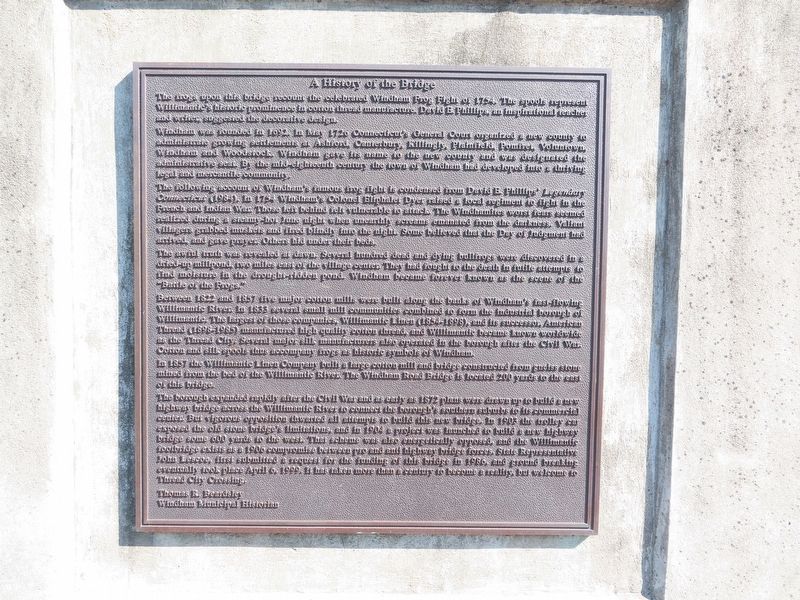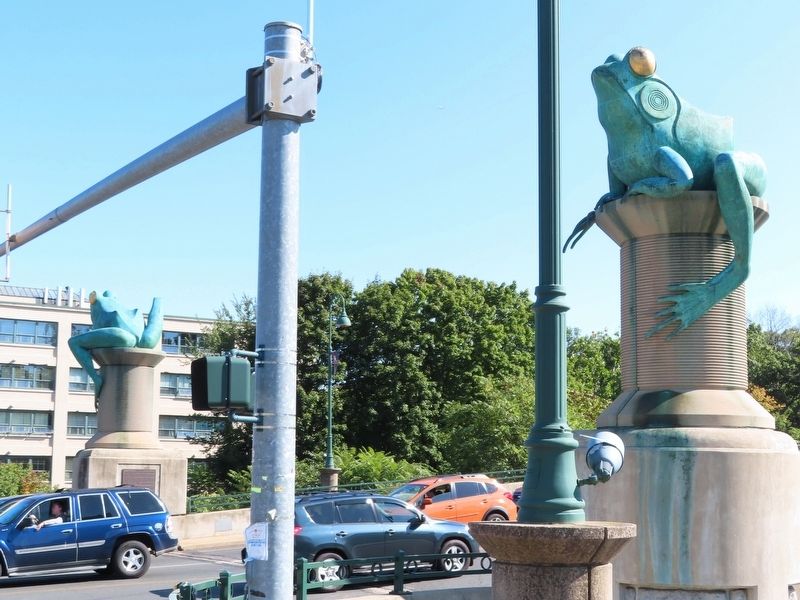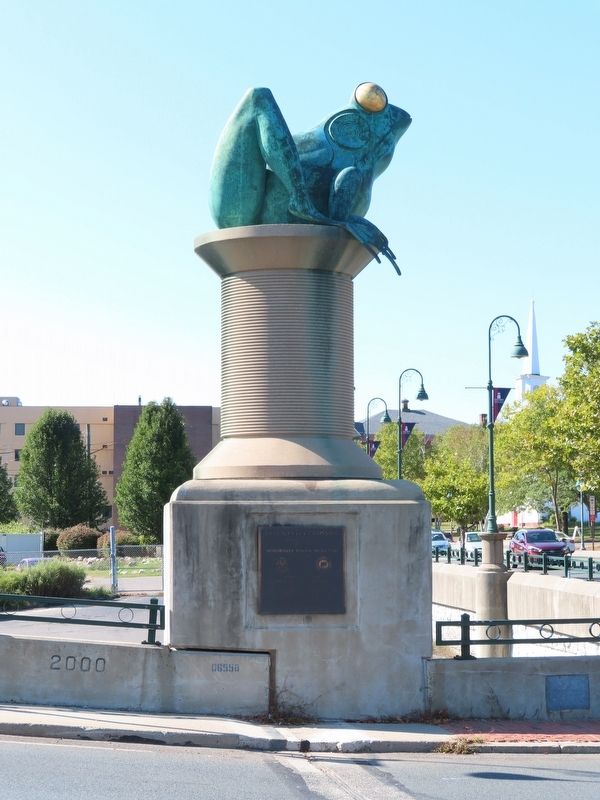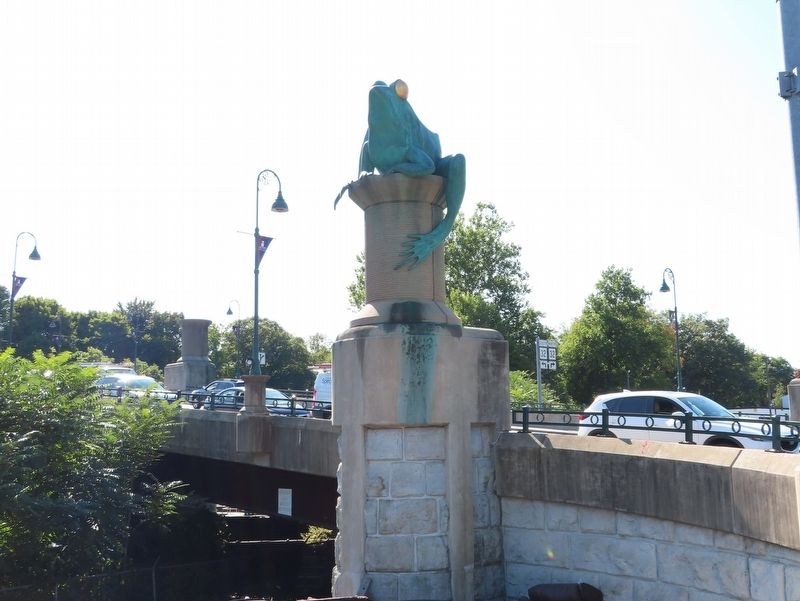Willimantic in Windham in Windham County, Connecticut — The American Northeast (New England)
Thread City Crossing
The frogs upon this bridge recount the celebrated Windham Frog Fight 0f 1754. The spools represent Willimantic’s historic prominence in cotton thread manufacture. David E. Phillips, an inspirational teacher and writer suggested the decorative design.
Windham was founded in 1692. In May 1726 Connecticut’s General Court organized a new county to administrate growing settlements at Ashford, Canterbury, Killingly, Plainfield, Pomfret, Voluntown, Windham and Woodstock. Windham gave its name to the new county and was designated the administrative seat. By the mid-eighteenth century the town of Windham had developed into a thriving legal and mercantile community.
The following account of Windham’s famous frog fight is condensed from David E. Phillips’ Legendary Connecticut (1984). In 1754 Windham’s Colonel Eliphalet Dyer raised a local regiment to fight in the French and Indian War. Those left behind felt vulnerable to attack. The Windhamites worst fears seemed realized during a steamy-hot June night when unearthly screams emanated from the darkness. Valiant villages grabbed musket and fired blindly into the night. Some believed that the Day of Judgement had arrived and gave prayer. Others hid under their beds.
The awful truth was revealed at dawn. Several hundred dead and dying bullfrogs were discovered in a dried-up millpond, two miles east of the village center. They had fought to the death in futile attempts to find moisture in the drought-ridden pond. Windham became forever known as the scene of the “Battle of the Frogs.”
Between 1822 and 1857 five major cotton mills were built along the banks of Windham’s fast-flowing Willimantic River. In 1833 several small mill communities combined to form the industrial borough of Willimantic. The largest of those companies, Willimantic Linen (1854-1898), and its successor, American Cotton Thread (1898-1985) manufactured high quality cotton thread, and Willimantic became known worldwide as the Thread City. Several major silk manufacturers also operated in the borough after the Civil War. Cotton and silk spools thus accompany frogs as historic symbols of Windham.
In 1857 the Willimantic Linen Company built a large cotton mill and bridge constructed from gneiss stone mined from the bed of the Willimantic River. The Windham Road Bridge is located 200 yards to the east of this bridge.
The borough expanded rapidly after the Civil War and as early as 1872 plans were drawn up to build a new highway bridge across the Willimantic River. To connect the borough’s southern suburbs to its commercial center. But vigorous opposition thwarted all attempts to build this new bridge. In 1903 the trolley car
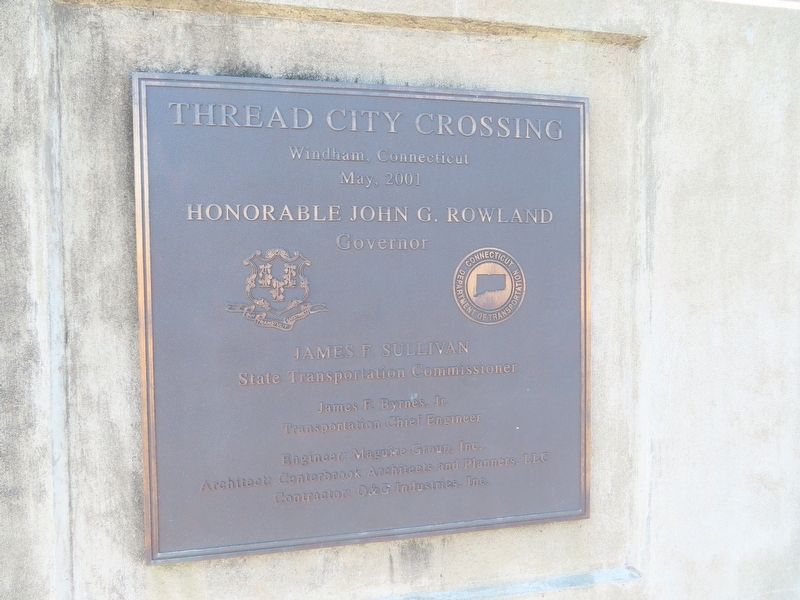
Photographed By Michael Herrick, September 19, 2019
2. Dedication Plaque
Windham, Connecticut
May, 2001
Honorable John G. Rowland
Governor
James F. Sullivan
State Transportation Commissioner
James F. Byrnes, Jr.
Transportation Chief Engineer
Engineer: Maguire Group, Inc.
Architect: Centerbrook Architects and Planners, LLC
Contractor: O&G Industries, Inc.
Thomas R. Beardsley
Windham Municipal Historian
Topics. This historical marker is listed in this topic list: Bridges & Viaducts. A significant historical date for this entry is April 6, 1999.
Location. 41° 42.637′ N, 72° 12.555′ W. Marker is in Windham, Connecticut, in Windham County. It is in Willimantic. Marker is at the intersection of Main Street and South Street (Connecticut Route 66), on the right when traveling east on Main Street. Located on the “Frog Bridge”. Touch for map. Marker is at or near this postal address: 627 Main Street, Willimantic CT 06226, United States of America. Touch for directions.
Other nearby markers. At least 8 other markers are within walking distance of this marker. Impressionism in Connecticut (approx. 0.2 miles away); Windham Tercentenary (approx. half a mile away); Windham World War I Monument (approx. half a mile away); Co.L First Inf. Memorial (approx. 0.6 miles away); Merchant Marine Veterans Memorial (approx. 0.7 miles away); Polish National Home World War II Monument (approx. 0.7 miles away); White Eagle World War II Monument (approx. 0.7 miles away); Staff Sgt. John V. Morascini (approx. 0.9 miles away). Touch for a list and map of all markers in Windham.
Related marker. Click here for another marker that is related to this marker.
Also see . . . Frog Bridge on Wikipedia. (Submitted on October 3, 2019, by Michael Herrick of Southbury, Connecticut.)
Credits. This page was last revised on June 27, 2023. It was originally submitted on October 3, 2019, by Michael Herrick of Southbury, Connecticut. This page has been viewed 231 times since then and 24 times this year. Photos: 1, 2, 3, 4, 5. submitted on October 3, 2019, by Michael Herrick of Southbury, Connecticut.
